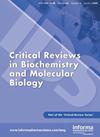HIV suppressors against LINE-1: one functions as two.
IF 6.4
2区 生物学
Q1 BIOCHEMISTRY & MOLECULAR BIOLOGY
Critical Reviews in Biochemistry and Molecular Biology
Pub Date : 2021-06-01
Epub Date: 2021-03-01
DOI:10.1080/10409238.2021.1893640
引用次数: 5
Abstract
Abstract Exogenous retroviruses are RNA viruses that require reverse transcription for their replication. Among these viruses, human immunodeficiency virus (HIV) is infectious to humans and causes the development of acquired immune deficiency syndrome (AIDS). There are also endogenous retroelements that require reverse transcription for their retrotransposition, among which the type 1 long interspersed element (LINE-1) is the only type of retroelement that can replicate autonomously. It was once believed that retroviruses like HIV and retroelements like LINE-1 share similarities in processes such as reverse transcription and integration. Accordingly, many HIV suppressors are also potent LINE-1 inhibitors. However, in many cases, one suppressor uses two or more distinct mechanisms to repress HIV and LINE-1. In this review, we discuss some of these suppressors, focusing on their alternative mechanisms opposing the replication of HIV and LINE-1. Based on the differences in HIV and LINE-1 activity, the subcellular localization of these suppressors, and the impact of LINE-1 retrotransposition on human cells, we propose possible reasons for the inhibition of HIV and LINE-1 through different pathways by these suppressors, with the hope of accelerating future studies in associated research fields.针对LINE-1的HIV抑制因子:一个起两个的作用。
外源性逆转录病毒是需要逆转录才能复制的RNA病毒。在这些病毒中,人类免疫缺陷病毒(HIV)对人类具有传染性,并导致获得性免疫缺陷综合征(AIDS)的发展。也有内源性逆转录元件需要逆转录才能进行逆转录转位,其中1型长穿插元件(LINE-1)是唯一一种能够自主复制的逆转录元件。人们曾经认为,像HIV这样的逆转录病毒和像LINE-1这样的逆转录元件在逆转录和整合等过程中有相似之处。因此,许多HIV抑制剂也是有效的LINE-1抑制剂。然而,在许多情况下,一种抑制因子使用两种或更多不同的机制来抑制HIV和LINE-1。在这篇综述中,我们讨论了其中的一些抑制因子,重点讨论了它们对抗HIV和LINE-1复制的替代机制。基于HIV和LINE-1活性的差异,这些抑制因子的亚细胞定位,以及LINE-1逆转录转位对人类细胞的影响,我们提出了这些抑制因子通过不同途径抑制HIV和LINE-1的可能原因,希望能加快相关研究领域的进一步研究。
本文章由计算机程序翻译,如有差异,请以英文原文为准。
求助全文
约1分钟内获得全文
求助全文
来源期刊
CiteScore
14.90
自引率
0.00%
发文量
6
期刊介绍:
As the discipline of biochemistry and molecular biology have greatly advanced in the last quarter century, significant contributions have been made towards the advancement of general medicine, genetics, immunology, developmental biology, and biophysics. Investigators in a wide range of disciplines increasingly require an appreciation of the significance of current biochemical and molecular biology advances while, members of the biochemical and molecular biology community itself seek concise information on advances in areas remote from their own specialties.
Critical Reviews in Biochemistry and Molecular Biology believes that well-written review articles prove an effective device for the integration and meaningful comprehension of vast, often contradictory, literature. Review articles also provide an opportunity for creative scholarship by synthesizing known facts, fruitful hypotheses, and new concepts. Accordingly, Critical Reviews in Biochemistry and Molecular Biology publishes high-quality reviews that organize, evaluate, and present the current status of high-impact, current issues in the area of biochemistry and molecular biology.
Topics are selected on the advice of an advisory board of outstanding scientists, who also suggest authors of special competence. The topics chosen are sufficiently broad to interest a wide audience of readers, yet focused enough to be within the competence of a single author. Authors are chosen based on their activity in the field and their proven ability to produce a well-written publication.

 求助内容:
求助内容: 应助结果提醒方式:
应助结果提醒方式:


